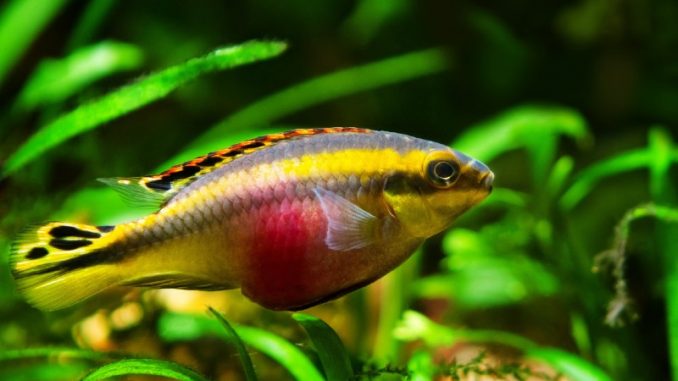
The kribensis is a type of cichlid, originating in West and Central Africa. Kribensis cichlids are freshwater fish and are known for their peaceful temperament. They’re beautifully patterned and relatively easy to care for, and this makes them a popular fish among aquarists.
Kribensis cichlids are classed as “dwarf cichlids“, which are small, peaceful cichlids that spawn easily.
A kribensis has specific needs and requirements, and isn’t compatible with all kinds of fish. You should research the needs of the kribensis before adding it to your aquarium.
TABLE OF CONTENTS
Kribensis Facts and Overview
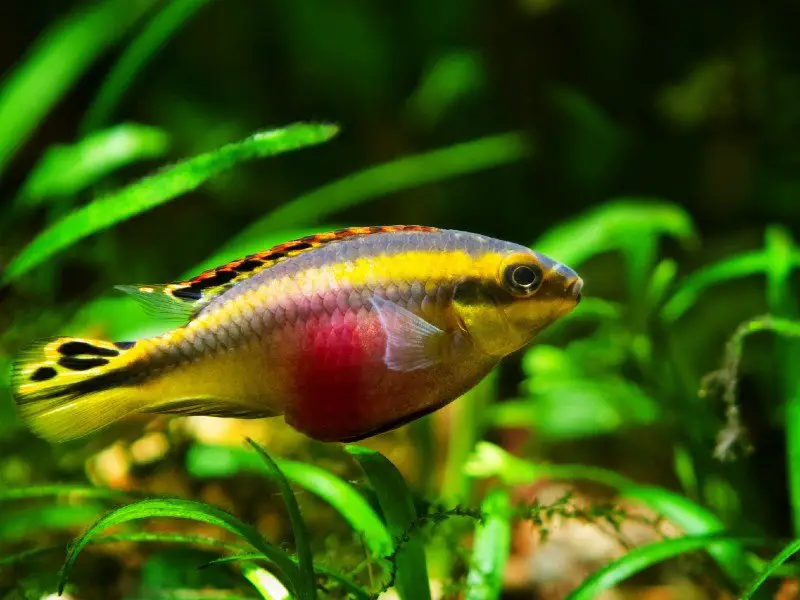
| Category | Rating |
| Care Level | Easy |
| Temperament | Peaceful |
| Color | Gray and yellow, with the trademark pink "blush" color on the stomach and sides in females, and red dots or red-tipped fins |
| Lifespan | 5–8 years |
| Size | Approximately 4 inches |
| Diet | Omnivore. Kribensis cichlids eat good-quality fish flakes and specially designed cichlid pellets, as well as a combination of live and frozen foods |
| Family | Cichlidae, scientific name Pelvicachromis Pulcher |
| Minimum Tank Size | 20 gallons |
| Tank Setup | Pelvicachromis Pulcher |
| Compatibility | Freshwater, caves, decorations, and plants |
Originating in Africa and the Nigerian Rivers, the kribensis cichlid is a type of dwarf cichlid. Cichlids can grow very large, but dwarf cichlids like the kribensis only grow to around four or five inches in length.
Kribensis typically live for 5–8 years, but with proper care, your fish can live for longer.
In the wild, the kribensis cichlid lives in both slow and fast-moving water. These fish prefer areas with dense vegetation, and typically prefer to stick to the bottom and middle of a tank.
While kribensis cichlids are becoming more popular, they’re not yet a household name, unlike fancy goldfish and betta fish. You’ll likely have to consult an experienced fishkeeper or check a few freshwater fish stores when looking for a kribensis to add to your aquarium.
A kribensis cichlid can cost between $10 and $20, depending on coloring, size, and the shop you buy it from.
Appearance and Behavior
Like other cichlids, kribensis cichlids are slim and have a rounded body shape. You will find varieties in color and pattern between kribensis cichlids, but the standard color is grey and white, with yellow tinges, red-tipped fins, and a black stripe. Some individuals also have black dots on their fins and scales.
Both male and female kribensis cichlids have yellow-tinged and red-tipped dorsal fins, but the males have long, pointed fins. The fins on the underside of the kribensis sometimes have streaks of metallic blue.
Females are approximately one inch smaller than males and have a noticeable pink tinge on their bellies and sides. During the breeding season, this color becomes more vibrant — more red than pink. Male kribensis cichlids are around four inches long. Females are noticeably smaller, only three inches long.
If your kribensis is well cared for, its colors will become more vibrant. Stressed fish may display muted colors. If your kribensis looks duller than usual, check your water parameters and quality, and see if anything could be stressing out your fish.
Typical Behavior
Kribensis cichlids are peaceful fish. Unlike other types of cichlid, a kribensis can be kept alongside other fish in a community tank. However, despite their relative peacefulness, kribensis cichlids may still display territorial behavior.
Around breeding time, a kribensis can become more aggressive and territorial, especially around caves or hiding places in the tank.
Behavior Toward Tank Mates
Kribensis cichlids are known as fin-nippers. This means that they like to chase and bite the long, flowing fins of their tank mates. This can be an issue if your kribensis is living in a community tank with other species of fish.
You shouldn’t keep a kribensis alongside slow-moving fish with long, flowing fins. Bites and nips can lead to the fish becoming injured, stressed, and susceptible to injury.
Behavior Toward Other Kribensis Cichlids
Too many kribensis males in one tank can be a problem. Kribensis cichlids aren’t particularly aggressive toward each other, but their temperament can change during the breeding season when males can become aggressive and territorial. To avoid this, you should always keep more females than males in a group of kribensis cichlids.
Swimming Behavior
Kribensis cichlids tend to stay near the bottom of the tank. They will be active during the day when the aquarium lights are on and will rest when it’s dark.
These fish like to root around in the gravel and swim in dense vegetation, so be sure to fill your tank with plenty of caves, plants, and other hiding places.
You can feed your kribensis in the morning and evening. Make sure to feed it a varied diet. These fish are relatively easy to care for, and will quickly adapt to different routines.
Kribensis Care
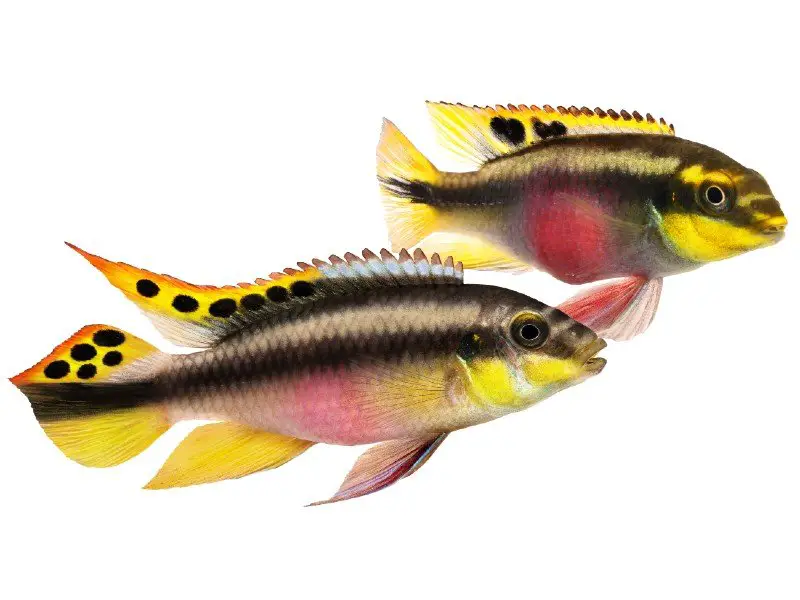
Kribensis cichlids are easy to care for. In the wild, they prefer dense undergrowth and caves, and eat small invertebrates and insects. These fish like plenty of hiding places, especially if you have spawning pairs in your tank.
You should set up your kribensis cichlid tank with plenty of plants, and feed them an omnivorous diet. If possible, you should change up their diet regularly, with live or frozen foods as a treat.
Kribensis cichlids are prone to many of the traditional diseases that affect freshwater fish. Ich, fungal infections, bacterial infections, and parasites can all affect your kribensis.
Most of these conditions need to be treated by quarantine and medication. You can maintain healthy fish by keeping the tank water in good condition, feeding the proper amount of food (no overfeeding), keeping the tank clean, and making sure your fish aren’t stressed.
Habitat and Tank Requirements
Kribensis cichlids live in rivers, predominantly near the riverbed, so they’re used to slow or moderately moving water conditions. Because their natural habitat is filled with caves, hiding places, and lots of undergrowth, these cichlids prefer tanks with these attributes.
Like any fish, your kribensis cichlids will thrive in conditions that best replicate their habitat in the wild. Live plants oxygenate the water and are cleaner than plastic plants, although kribensis cichlids tend to uproot and eat live plants.
Tank Conditions
Make sure you have a properly cycled tank set up and ready before you bring home a kribensis. Kribensis cichlids can tolerate different water parameters, but keeping the tank water in good condition and properly regulated is the best way to make sure your fish lives as long as possible.
Tank Size
Start with a minimum tank size of 20 gallons. Bigger is always better, and your fish will be happier and less stressed in a larger tank. For more than one kribensis cichlid, start with a 30-gallon tank.
A large tank is especially important if you intend to breed your cichlids. The fish can become aggressive around the breeding time, especially regarding their territory.
Water Quality
Kribensis cichlids prefer soft water, with a pH level between 5.0 and 8.0. They prefer temperatures of 75–79 degrees Fahrenheit.
Low to moderate water flow is best for kribensis cichlids, and they prefer low lighting.
Decorations and Substrate
Kribensis cichlids like lots of dense vegetation, and plenty of hiding places. Caves are important, especially if you have breeding pairs, as the pairs will fight over the cave spots.
Fine gravel is best to use for substrate because it best replicates the kind of substrate they would encounter in the wild. Cichlids like to dig around in the substrate, and fine gravel is easier for them to dig into.
You can create caves for your cichlids out of coconut shells, decorations, or pots. Make sure that whatever decorations you use for caves are smooth, to prevent any injury to your fish.
Tank Mates
Unlike most cichlids, kribensis cichlids are relatively peaceful, meaning that they can be kept with many different types of fish. However, they shouldn’t be housed with slow-moving fish with long fins, due to their tendency towards fin-nipping.
Aggressive or territorial fish will bully your kribensis. Ideally, you should house your kribensis cichlids alongside peaceful, non-aggressive fish.
Some good tank mates for kribensis cichlids include:
- Corydoras catfish
- Siamese algae eaters
- Snails
- Harlequin rasboras
- Tiger barbs
- Other dwarf cichlids
You shouldn’t keep kribensis cichlids with other cave-dwelling fish, as this will lead to territorial disputes and aggression.
Disease
Kribensis cichlids are prone to most of the common freshwater fish diseases, including the following:
Ich
Ich, also known as white spot disease, presents itself as white spots all over the fish’s body and fins. Other symptoms include a loss of appetite, lethargy, rapid breathing, or rubbing (“flashing”) over the tank or decorations.
If you suspect a fish has ich, quarantine it immediately. However, as the disease is extremely contagious, the other fish in the tank may already be infected. Your best course of action is to treat the whole tank and all the fish. For a tropical fish like a cichlid, you can start by turning up the temperature in the tank, as higher temperatures speed up the life cycle of the ich parasite.
Consult a vet for other medications to add to your tank.
Fungal infections
Infections, particularly fungal infections, are more common in stressed or injured fish. Fungal infections are often called “cotton wool disease” because the infection often looks like a patch of cotton wool on your fish’s body or fins.
You can purchase antifungal treatments for fish in most fish stores. Make sure the tank water stays properly oxygenated, as some medications can dissolve water oxygen. If possible, quarantine the affected fish.
Injuries and infections
Injuries from fighting or spawning can leave a fish susceptible to infections, including the dreaded ich. You can prevent illness and infections by making sure that your fish aren’t stressed or overcrowded.
Overcrowded fish are more likely to fight, so make sure you don’t have more fish in your tank than is comfortable. Never put incompatible fish together in the same tank.
Diet and Feeding
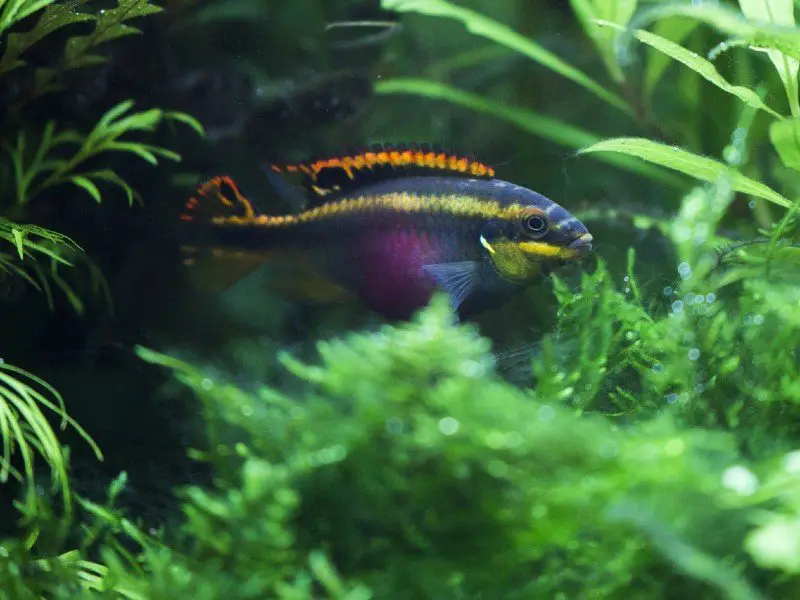
In the wild, kribensis cichlids are omnivores and eat algae, small plants, small invertebrates, and insects. If possible, feed your kribensis cichlids live food on occasion. If you’re not able to feed your fish live food, try frozen food.
For day-to-day feeding, good-quality tropical fish flakes and cichlid pellets are good for your kribensis. Feed your kribensis at the same time every day. The fish will eat just about anything, but you should vary their diet for the best results. Cichlids will eat food from the bottom of the tank, so sinking pellets are also suitable.
Feed your kribensis enough food for a two-minute feed. It’s easy to overfeed your fish, and surprisingly difficult to underfeed them. Scoop out any leftover food, as this food will disintegrate and pollute the water.
Breeding
Breeding kribensis cichlids is easier than breeding most other fish. Cichlids will breed in community tanks, but this carries a risk that the eggs could be eaten. To give the fry their best chance of surviving, set up a separate breeding tank, away from other hungry fish.
Raise the temperature in the tank to around 80 degrees Fahrenheit, and introduce the bonded pair. Make sure there’s a spacious cave in the tank, as the fish won’t breed without it. They may even clear out the cave before spawning, tossing out bits of gravel to make more space inside.
You’ll notice the female kribensis cichlid’s stomach swelling with eggs. She will lay her eggs in the cave, and guard them inside, while the male stays on guard outside.
After 5–7 days, the eggs will hatch. In another 5 days, the fry will become free-swimming and will start following their parents around. To feed the babies, you’ll need special powdered fry food or liquid fish food.
The parent cichlids will care for their babies as they grow, but watch out for possible aggressive behavior.
Essentially, all you need to do is to provide a cave, food, and clean water for your kribensis cichlids, and they will breed easily.
However, if you notice that the mating pair is acting aggressively toward each other, or simply don’t seem interested, it might be best to separate them and try again with another pair.
Should You Get a Kribensis Cichlid For Your Aquarium?
Kribensis cichlids are peaceful and easy to care for. However, if you plan to have several kribensis cichlids in a tank, be aware that you could find yourself with a lot of fry to deal with. Kribensis cichlids shouldn’t be paired with slow-moving, fancy fish, or with other cave-dwelling fish.
Because Kribensis cichlids are beautiful and placid, they make a good fish for beginner aquarists. They have delicate, vibrant colors, and the females’ pink bellies are particularly colorful.
If you’re looking for a new kind of fish, preferably one that isn’t too challenging, kribensis cichlids are a species to consider.

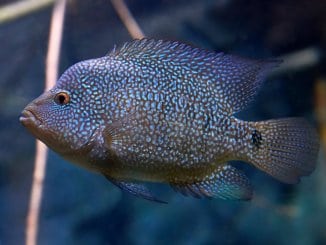
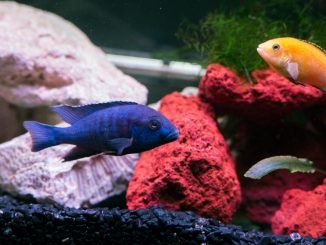
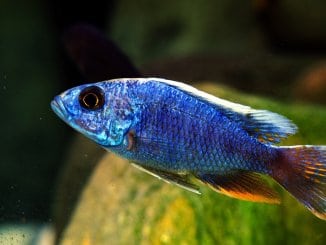
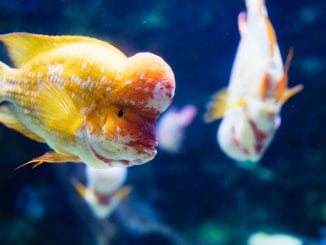
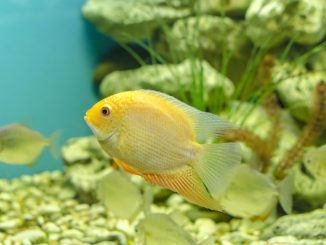
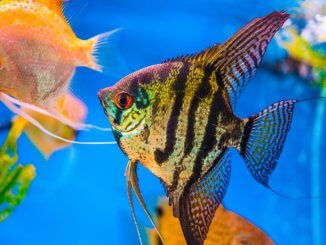
Be the first to comment